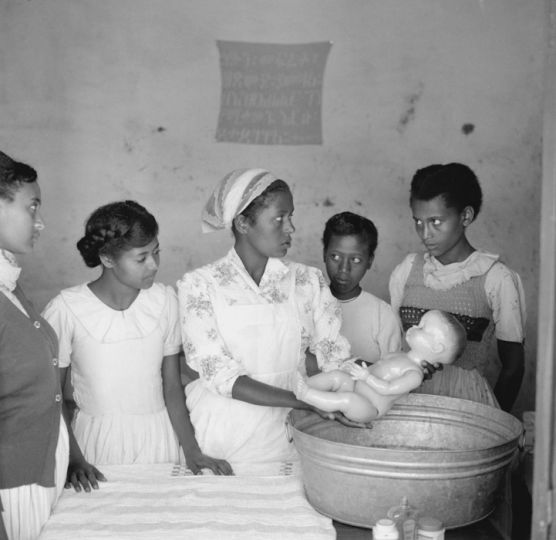The complete works of Paul Almasy are available. At last! – one is tempted to say. After 22 years of archiving, processing, curating and sighting all shows of the remarkable photographer‘s career are packed in boxes, complete with all his works, ready to be exhibited and admired. Opening this ‘second’ world premiere since 1999, the seventh show of the gallery proudly uses the title so often bestowed to Paul Almasy, the trained diplomat, within the UN-institutions: “The Eye of the WHO”. The exhibition of this title demonstrates why the aristocratic Hungarian Paul Almasy remains unique in the history of photography: by keeping his distance, he preserved the dignity of his subjects. He did not subscribe to Capa‘s widely accepted belief that getting closer to people would lead to a better image. The natural dialectics of his nobility developed in him an approach both courageous and shy, characterised by his visibly empathetic humanism. His colleagues, especially fellow WHO photographers such as Eduard Boubat, Robert Capa, the warhorse among photo reporters, Robert Doisneau, Marc Riboud or David Seymour, co-founder of Magnum in Paris, admired him for it.
Owing to his heritage, Almasy had access to the courts of emperors and kings, pashas, shahs and sultans, which is part of why he always stood out like a solitaire. Cut from different cloth than the Bohème of his Parisian colleagues, throughout his life he kept his distance to the people he encountered during his travels, facilitated by his lens, albeit with sympathy and affection. “Coincidence decided everything,” he modestly told me. Could that be true? His disarming approach to people, the triad of empathy, openness and curiosity, made sure to meet them on an equal level. Not a trace of arrogance or presumption are found in his depictions of poverty or misery. His portraits of emperors, kings, despots and politicians on the other hand, carefully designed to ban coincidence from their vain circle of power, appear courtly and banal. Each of Almasy‘s ‘works’ however reveals a dialogue with all the people he met and encountered in a visible and lasting way, preserved for posterity. This photo reportage is the work and the voice of a true global citizen. Again and again, he demonstrates an important truth: human dignity is inviolable. Paul Almasy: a photo reporter’s life’s work (1906-2003) is complete. Beginning in 1936 with a tour of the Saharan desert as a commission for Berliner Illustrierte Zeitung. The image of his packed Citroen, from Paris to Algier, was circulated beyond Africa through the Gazettes and around the world. The picture shows the car ‘driving’ from right to left – interpreted cinematically – against time back to the beginnings. Provenience is (almost) everything, after all.
Paul Almasy‘s oeuvre is a historic feat of photography about the century of mobility. It is also a collection of its modes of transport – featuring everything that moves. We see the droves of workers and the two poachers on their way home, we see passersby, travellers, commuters: a woman with a cart, a Roma shouldering her heavy load, a child carrying boxes on his head, a footman carrying a customer on his back, a thin Rickshaw driver heaving a fat man through bustling Saigon streets, a grandmother from Japan holding her little grandchild, an Arab in a stagecoach, two Iraqis paddling a kuphar in the Euphrates river, a child drinking thirstily on the train. And images of Paul Almasy himself, a progression of early selfies paints a self-portrait of constant movements spanning half a century: Almasy on foot and on horseback, riding a donkey, a camel, a dromedary, Almasy carried through the jungle of Madagascar in a sedan, Almasy in the Citroen of the BIZ from Algeria to the African interior, Almasy on a barge, Almasy on board of the ‘Monte Rosa’, Almasy at the railing of the ‘Raine Astrid’, Almasy on a zeppelin airship, in a moored balloon, on a bus, on the Sahara Express, on a draisine on rails in the Andes, Almasy on a sailing ship off Argentina, and from the 1930s Almasy on planes, on the aircraft carrier ‘Midway’ in the Atlantic, and later still in a Volkswagen Beetle in the Peruvian mountains. Towards the end of his career in reportage, how lucid and prosaic – the year is 1975 – the image of him in a traffic jam on La Périphérie of Paris. Constantly on the move for world-class Gazettes, his mobile lifestyle as reporter granted him an almost biblical age of 97. And with him, the era of increasing movement and mobility, aged and tired.
Beginning with the show “The Eye of the WHO” in spring of 2020 one is to follow every year, gradually presenting the viewer with the complete works. Let us – posterity – focus on the only valid, strictly limited and signed edition of 10 copies as decreed by Almasy as his complete work. Starting in 1998, he himself made the selection from his vast archive of 120,000 negatives – arguably the greatest of the pioneer era of photo reportage, not just in volume. May the globetrotter with Grandezza – holy ‘Benedikt of Cologne’ – now find a home with truly grand and global publisher. Until then the prints of the complete works, as remaining since the 1999 sale, will be available at the special price of 2,000 Euro (plus VAT and shipping costs) for one day only (21.02.2020 from 00:00 until 24:00 CET) via Kleinschmidt Fine Photographs to mark the opening of the seventh exhibition at the end of February. The special sale price will be applied to all incoming orders carrying the server time stamp of this date. After this, masterprints can be obtained at the regular sale price.
More information on: http://www.klauskleinschmidt.de
Information
Kleinschmidt Fine Photographs
Steubenstraße 17, 65189 Wiesbaden, Germany
February 28, 2020 to April 03, 2020





















